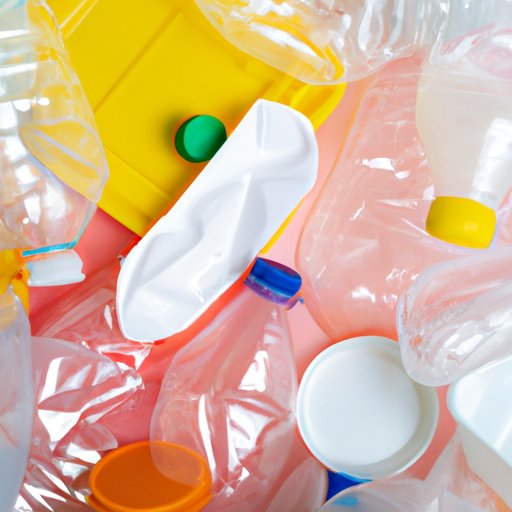Introduction
With the world’s increasing dependence on plastics, we are producing more plastic waste than ever before. The problem is that most plastics do not biodegrade and end up polluting our environment. Recycling is the solution, but not all plastics are created equal. In this article, we will explore which plastics can be recycled and how you can recycle them.
Understanding Plastics
There are seven types of plastic, each with its own unique properties. Understanding these properties is essential when it comes to recycling.
The different types of plastics are:
- PET (Polyethylene Terephthalate)
- HDPE (High-Density Polyethylene)
- PVC (Polyvinyl Chloride)
- LDPE (Low-Density Polyethylene)
- PP (Polypropylene)
- PS (Polystyrene)
- Other (including polycarbonate, nylon, and acrylic)
Another important aspect is the resin identification code, which identifies the plastic type. These codes are usually located on the bottom of products and help with proper sorting and recycling.
Types of Plastics That Can be Recycled
The seven types of plastic that are typically recyclable are:
- PET (Polyethylene Terephthalate) – used for water bottles, soda bottles, food packaging, and some textiles.
- HDPE (High-Density Polyethylene) – used for milk jugs, detergent bottles, and toys.
- PVC (Polyvinyl Chloride) – used for pipes, window frames, and vinyl siding.
- LDPE (Low-Density Polyethylene) – used for grocery bags, garbage bags, and food packaging.
- PP (Polypropylene) – used for yogurt cups, bottle caps, and some food containers.
- PS (Polystyrene) – used for foam cups, packaging peanuts, and insulation.
- Other (including polycarbonate, nylon, and acrylic) – used for eyeglasses, compact discs, and some food packaging.
It is essential to check with your local recycling center to ensure all of these plastics are recyclable in your area. It is also important to note that not all products made of these plastics are necessarily recyclable.
Recycling each type of plastic has its specific method, which may vary depending on the area you live in. Make sure to check with your local recycling facility to ensure proper disposal. However, some general guidelines include:
- Remove all labels and caps before recycling.
- Wash out any food containers before recycling.
- Do not recycle plastic bags or wrap as they can tangle in recycling equipment.
Importance of Recycling Plastics
Plastic waste is a massive problem worldwide. Landfills are quickly filling up with plastic waste that takes thousands of years to degrade, and much of it is not biodegradable. Plastic pollution harms wildlife and their natural habitats, and it may also harm human health.
Recycling plastics help conserve finite resources, reduce landfill space, and reduce greenhouse gas emissions that occur due to the production of new plastics.
Proper Sorting of Recyclable Plastics
Proper sorting of recyclable plastics helps avoid contamination, allowing for higher-quality recycled products. Contamination occurs when a non-recyclable item is mixed in with the recyclables. This causes the whole batch to be unusable and ends up in the landfill.
Remember to follow your local recycling guidelines and check whether the plastic should be rinsed before recycling and whether plastic types should be sorted by color. Properly sorting plastic ensures that the correct plastics go to the correct recycling facility.
Understanding the Plastic Recycling Symbol
The plastic recycling symbol does not necessarily mean the item is recyclable. Instead, it indicates the resin identification code and helps with proper sorting.
PET (Polyethylene Terephthalate) and HDPE (High-Density Polyethylene) are the most commonly recycled plastic types. LDPE (Low-Density Polyethylene) and PP (Polypropylene) are only selectively recycled, while PVC (Polyvinyl Chloride) and PS (Polystyrene) are not recycled widely due to technical difficulties. Other plastics are usually not recycled.
Tips for Reducing Plastic Waste
Reducing your plastic waste can have a significant impact on the environment. Here are some practical tips:
- Use reusable bags, water bottles, and straws.
- Avoid single-use plastic products such as utensils and plates.
- Choose products with minimal plastic packaging.
- Buy products made of recycled plastic.
- Avoid using plastic bags or wrap.
By reducing plastic waste, you help offset the demand for new plastic production, thereby reducing overall pollution and environmental issues.
The Economics of Plastic Recycling
Recycling plastics is not only environmentally friendly, but it is also economically beneficial. Producing new plastic products consumes more energy and resources than recycling plastic to create new products. The recycling process conserves energy and resources by reducing the amount of plastic that needs to be produced from scratch.
Recycling plastics also has a positive impact on the economy. The recycling industry generates thousands of jobs and revenues from recycling programs and the production of new recycled plastic products.
Common Myths about Plastic Recycling Debunked
There are many myths surrounding plastic recycling, which can lead to confusion and misinformation. Here are some common misconceptions debunked:
- Myth: All plastics can be recycled.
Fact: Only certain plastics are recyclable, and recycling varies by region and facility. - Myth: The recycling symbol on a plastic product means it is recyclable.
Fact: The recycling symbol indicates the resin identification code and does not indicate that the product is recyclable in your area. - Myth: Plastic can only be recycled a limited number of times.
Fact: Plastic can be recycled multiple times, but the quality may degrade with each cycle.
Conclusion
Recycling plastics is an essential step towards creating a more sustainable future. Proper sorting of recyclable plastics, understanding what can and cannot be recycled, and reducing plastic waste can have a significant impact on the environment and economy. By working together, we can make a difference and reduce pollution and waste, one plastic item at a time.
